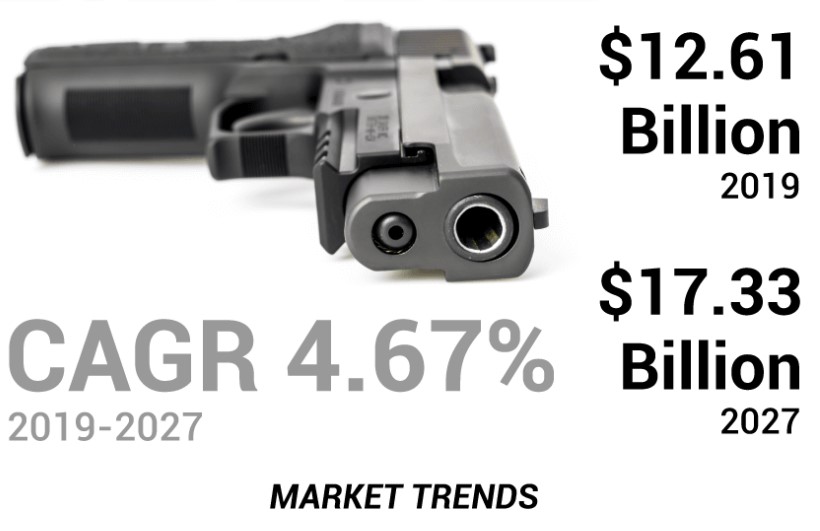
In 2019, the global light weapons market size was valued at $12.61 billion, and it’s expected to grow to $25.61 billion by 2032, with an annual growth rate of 5.6% over the forecast period. North America led the market that year, holding a 44.96% share of the total market.
Informational Source:
https://www.fortunebusinessinsights.com/light-weapons-market-103529
Overview of the Light Weapons Market
The light weapons market has been witnessing significant growth due to advancements in technology, rising global defense spending, and increasing demand from military and law enforcement agencies. These weapons, characterized by their portability and high lethality, include small arms, man-portable launchers, light machine guns, and mortars. The market is driven by both modernization initiatives in armed forces and the need for enhanced security measures worldwide.
Market Size and Growth Trends
As of 2019, the global light weapons market was valued at $12.61 billion and is projected to reach $25.61 billion by 2032, growing at a compound annual growth rate (CAGR) of 5.6% during the forecast period. North America has been the dominant regional market, accounting for nearly 45% of the global share in 2019. This growth is attributed to high defense budgets, ongoing technological advancements, and significant investments in modernizing military equipment.
Technological Advancements
-
Smart Weapons Integration:
-
Light weapons are increasingly being integrated with smart technology, such as advanced targeting systems and AI-based enhancements. These features improve accuracy, reduce collateral damage, and enable better situational awareness.
-
Examples include smart scopes, fire control systems, and laser-guided projectiles that enhance precision in urban and battlefield scenarios.
-
-
Lightweight Materials:
-
The use of composite materials, such as carbon fiber and advanced polymers, has significantly reduced the weight of weapons, making them more portable without compromising durability and performance.
-
These materials also improve weapon longevity and reduce maintenance costs.
-
-
Additive Manufacturing (3D Printing):
-
3D printing technology is being used to create customized weapon components, allowing manufacturers to produce lighter and more efficient designs at reduced costs.
-
This technology also facilitates rapid prototyping and shorter production cycles.
-
Key Drivers of Market Growth
-
Modernization Programs:
-
Countries are investing heavily in upgrading their defense arsenals, leading to increased procurement of advanced light weapons.
-
For example, NATO members are undergoing significant weapon modernization to meet alliance standards and improve interoperability.
-
-
Rising Asymmetric Warfare:
-
The prevalence of unconventional and asymmetric warfare has heightened the demand for light weapons that are versatile and effective in diverse combat environments.
-
This is particularly evident in counter-terrorism and guerrilla warfare operations.
-
-
Increased Border Security Measures:
-
Nations are enhancing border security in response to rising geopolitical tensions and cross-border threats, driving the demand for light weapons for patrol and surveillance teams.
-
Challenges in the Market
-
Stringent Regulations:
-
The global trade of light weapons is subject to strict regulations and international treaties, such as the Arms Trade Treaty (ATT). These policies aim to prevent illicit trafficking and misuse, which can hinder market growth.
-
-
Risk of Proliferation:
-
The widespread availability of light weapons raises concerns about their use in illegal activities and by non-state actors, leading to increased scrutiny and control measures.
-
-
High Costs of Advanced Technologies:
-
While advanced features improve weapon effectiveness, they also increase production costs, which can be a barrier for some governments and organizations with limited budgets.
-
Regional Market Insights
-
North America:
-
Dominates the market due to substantial defense spending, a strong manufacturing base, and ongoing research and development (R&D) efforts.
-
The United States is the largest contributor, driven by military modernization and homeland security initiatives.
-
-
Europe:
-
A significant market, with countries such as the UK, France, and Germany investing in defense upgrades and counter-terrorism measures.
-
The region also benefits from a robust defense manufacturing sector and collaboration between EU nations on joint projects.
-
-
Asia-Pacific:
-
The fastest-growing region, fueled by rising defense budgets in countries like China, India, and South Korea.
-
Border disputes, regional conflicts, and counter-insurgency operations are key drivers of demand in this region.
-
-
Middle East and Africa:
-
Increasing defense expenditures and ongoing conflicts have led to a growing market for light weapons.
-
Nations in the Gulf Cooperation Council (GCC) and North Africa are significant contributors.
-
-
Latin America:
-
Demand is primarily driven by efforts to combat drug cartels and organized crime, with governments investing in advanced light weapons for law enforcement.
-
Key Players in the Market
The light weapons market is highly competitive, with prominent players investing in innovation and partnerships to strengthen their positions. Key companies include:
- ARSENAL (Bulgaria)
- BAE Systems (The U.K)
- FN HERSTAL (Belgium)
- General Dynamics Corporation (The U.S.)
- Heckler & Koch GmbH (Germany)
- Lockheed Martin Corporation (The U.S.)
- Northrop Grumman Corporation (The U.S.)
- Raytheon Technologies Corporation (The U.S.)
- Rheinmetall AG (Germany)
- Saab AB (Sweden)
- Thales Group (France)
Future Outlook
The light weapons market is set to witness sustained growth, driven by technological advancements, geopolitical tensions, and increased defense spending. Emerging trends include the integration of artificial intelligence (AI) for autonomous targeting, development of hybrid propulsion systems for portable launchers, and enhanced safety features to prevent unauthorized use. Furthermore, collaborations between defense manufacturers and governments will continue to play a critical role in shaping the market.





Leave a Reply